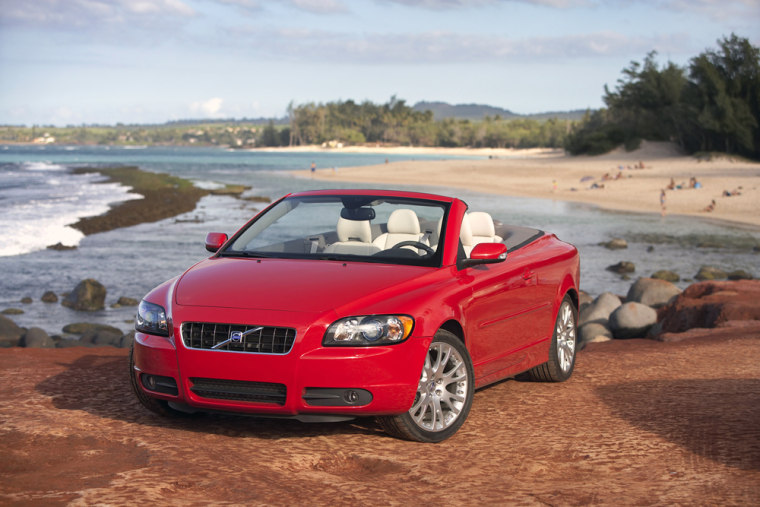For many new convertible owners, there’s no need to put the car away for the winter.
This year has seen one of the most competitive and sizable convertible markets in decades, dominated by new, lower-priced hardtops that aim to offer both the open-air delight of warm, sunny days and the security and snugness of regular cars when the cold moves in.
“If you’re in Chicago, this is a fine car to drive in the wintertime,” asserts Volkswagen spokesman Steve Keyes of his company’s Eos. Along with the Pontiac G6 Convertible, Volvo C70 and Mazda MX-5 Miata Power Retractable Hard Top, it’s one of a number of models this year that are changing the convertible world.
Not least in price.
Just last year, an American consumer couldn’t find a new, power-operated hardtop convertible for less than $40,000. Now, three of the nine models with power-operating hardtop have starting retail prices under $30,000. In addition, a record 40 convertible nameplates, softtop and hardtop, are on sale in the United States, and 30 percent of them have starting prices under $33,000. That puts them within reach of many mainstream buyers.
The previous lowest-priced hardtop convertible on the U.S. market was the two-seat Mercedes-Benz SLK280, which started at $44,125 in 2007. The new price leader is the 2007 MX-5 Miata with power hardtop, which began arriving in showrooms late this summer, starting at $24,945.
VW's 2007 Eos is the second lowest-priced hardtop, starting at $28,620, and the 2007 Pontiac G6 is third, at $29,150. Indeed, they are only $850 to $1,380 more, respectively, than the starting price of a 2007 Toyota Camry Solara Convertible with a fabric top.
“Convertibles are on the rise again,” said Jim Hall, analyst for automotive research firm AutoPacific Inc. of Tustin, Calif.
Automakers like stylish convertibles because they can attract new buyers to a brand. Jace Stokes, Pontiac product manager, says the G6 Convertible's appearance has drawn people into dealerships “in areas of the country that have not traditionally been strong for Pontiac.”
Higher priced than comparable sedans and coupes, convertibles also can be profitable for carmakers, Hall said. And it doesn't hurt that auto company executives generally just like eye-catching, open-top vehicles, he added.
VW’s Keyes said the U.S. market is following what has been going on in Europe. VW officials decided they needed a hardtop convertible more than three years ago after learning that Peugeot and Renault would be introducing models.
“They are, at least in Western Europe, major competitors to Volkswagen,” Keyes said.
Hall said BMW also is putting a hardtop on its next 3-Series convertible. And Chrysler’s 2008 Sebring convertible will be offered with a power-operated hardtop.
While softtops now dominate in the United States, some analysts say hardtops might account for the majority of convertible sales by 2015.
Why the shift?
The first mass-produced, retractable hardtop was Ford’s 1957 Skyliner, but its top worked slowly and its operation was complex. Sales were pitifully small.
Today, technology and new materials help make the new hardtops easier, more reliable and more cost-effective.
And consumers see benefits to hardtops, which are less prone to break-ins and vandalism, and can be easier to care for and clean than fabric tops. When a hardtop is on, the car may be safer in a crash than a softtop car. Hardtop convertibles also tend to be quieter than fabric-topped cars when the roofs are on.
There’s also the “wow” from bystanders watching the intricate folding of the roof sections into the vehicle's back end.
To be sure, there are drawbacks. Though prices are coming down, hardtops still are more expensive than comparable softtops. The lowest-priced convertible, overall, in the U.S. market this year has been the Chrysler PT Cruiser with fabric roof, which starts at $20,530.
Hardtops tend to weigh more than comparable softtop models, and, with a metal roof, can even weigh more than a comparable coupe with fixed roof. With more weight, fuel economy and handling can suffer.
Mechanical complexity also increases with a power-operated hardtop, making repairs more costly. The Eos’ top, for instance, has eight motors. It’s not uncommon for hardtops to have 10 or 12 motors.
In addition, the extra room needed to store a hard top typically reduces trunk space. The Pontiac G6 Convertible, for example, has only 2.2 cubic feet of trunk room when the roof is folded and stored, down from the maximum 12.6 cubic feet when the roof is on. The sibling G6 sedan comes with 14 cubic feet of trunk room.
A final note: Convertibles set a record in new-vehicle registrations of 315,306 in calendar 2004. But they remain a minor niche, accounting for only about 3 percent of total vehicle sales in the country.
